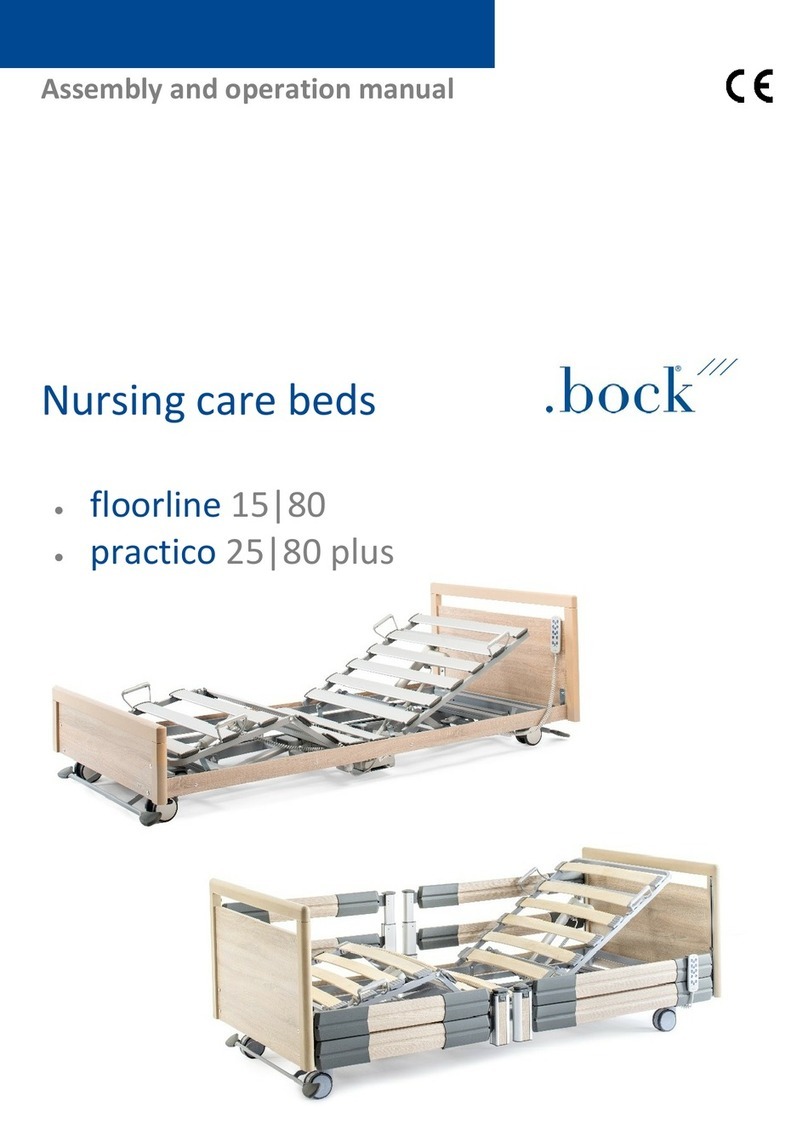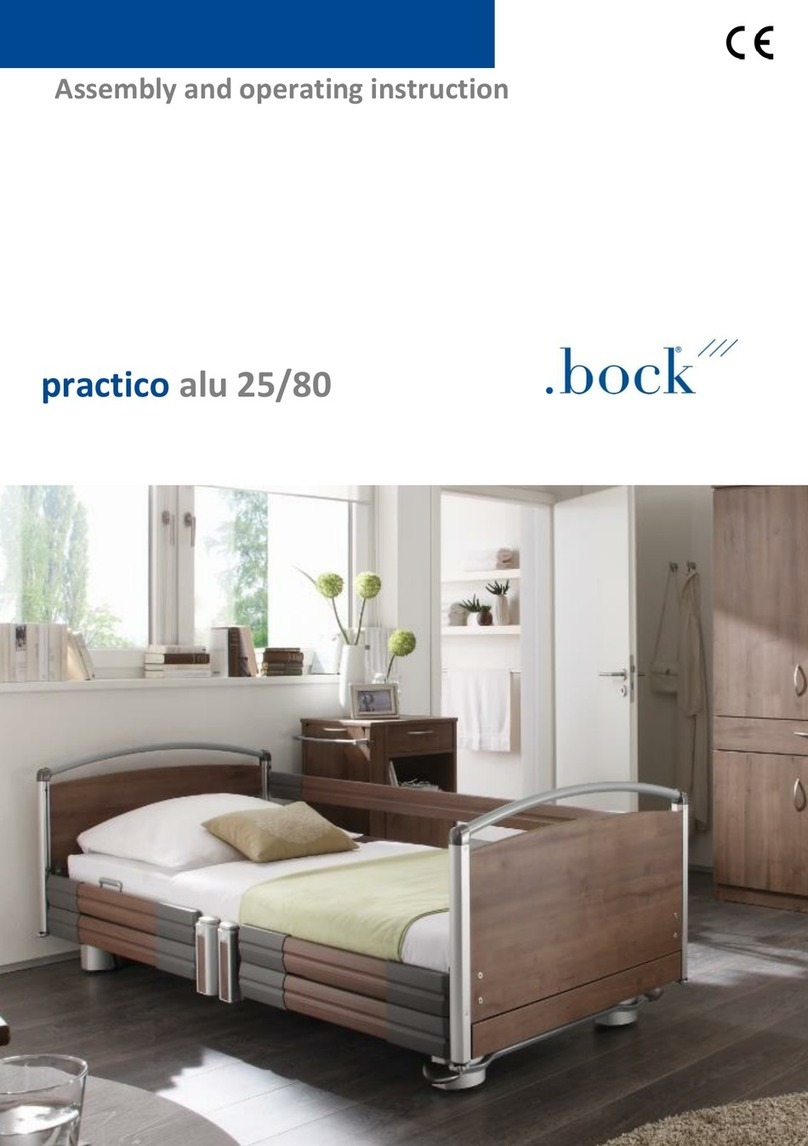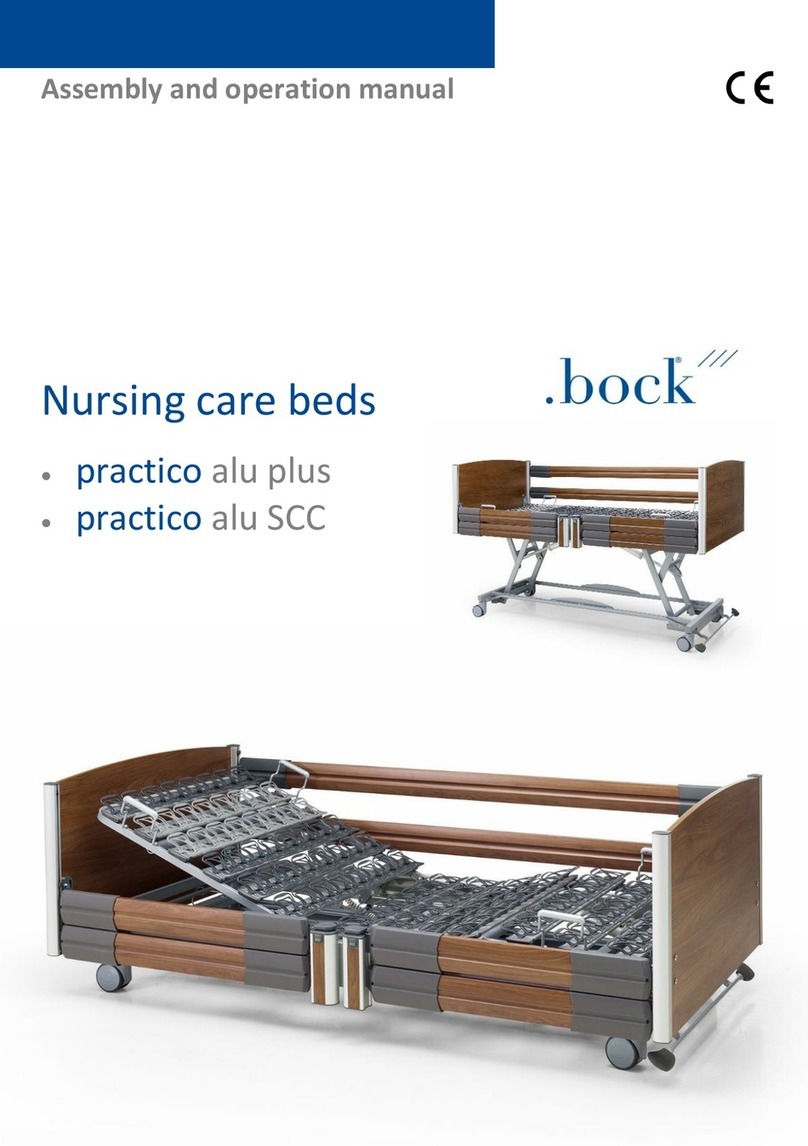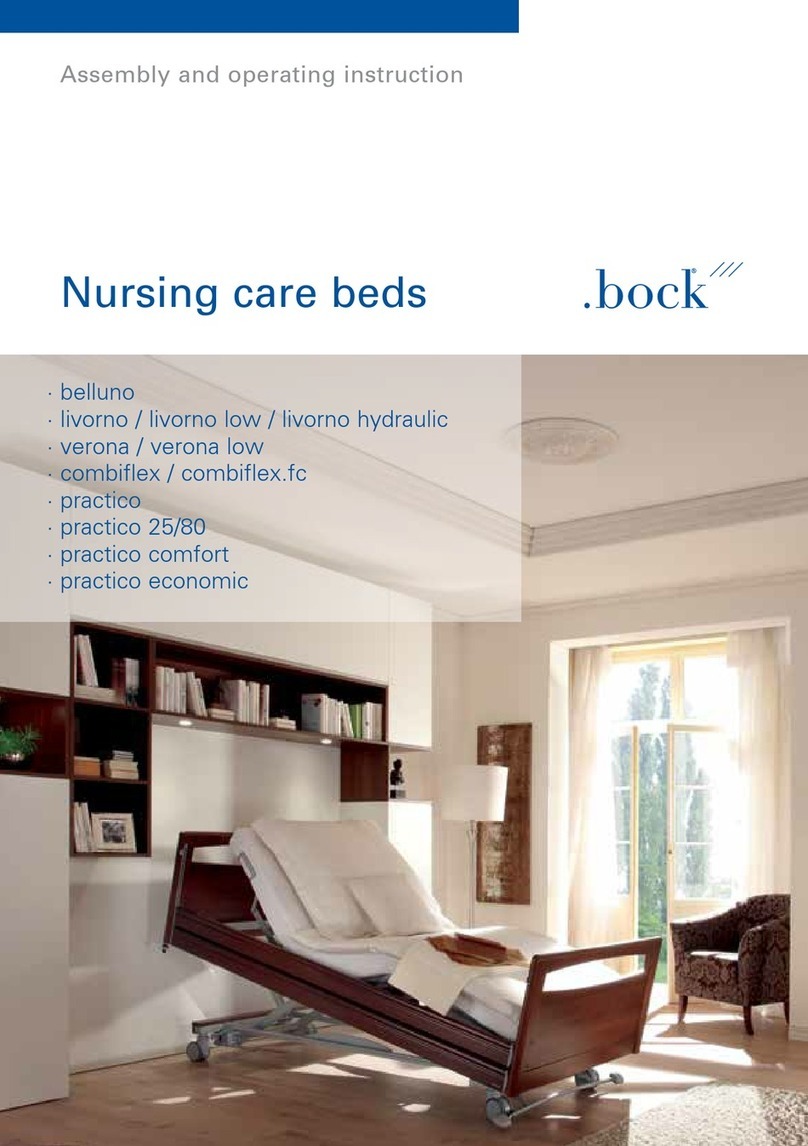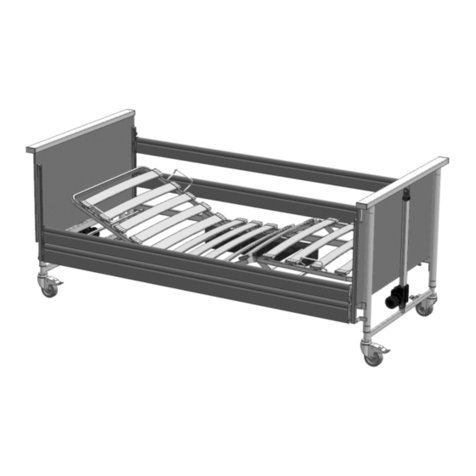BOCK Stellar Installation and operating instructions

1
Assembly and operation manual
Comfort/nursing care bed
stellar

2
Dear valued customer,
with your decision to purchase a comfort/nursing care bed from Hermann
Bock GmbH, you are receiving a long-lasting care product with superior
functionality at the highest safety level. Our electrically operated com-
fort/nursing care beds guarantee optimal lying comfort and allow profes-
sional care at the same time. This product was designed with a focus on the
elderly, whose confidence must be reinforced and whose life needs protec-
tion. With this health care product, we meet these requirements.
We urge you to prevent potential malfunctions and the risk of accidents by
complying strictly with the safety and operating instructions and by carry-
ing out the necessary maintenance.
Klaus Bock Dr. Stefan Kettelhoit

3
Table of contents
1Preface and general instructions ......................................................................... 4
1.1 Intended purpose.............................................................................................. 4
1.2 Definition of person groups .............................................................................. 5
1.3 Safety instructions............................................................................................. 6
1.4 Service life / warranty ....................................................................................... 7
1.5 Requirements for the installation location ....................................................... 7
1.6 Type plate.......................................................................................................... 8
2General description of the functions.................................................................. 10
3Electric parts ..................................................................................................... 14
3.1 The drive unit .................................................................................................. 14
3.2 Caution: Electric drive ..................................................................................... 14
3.3 Drives............................................................................................................... 15
3.4 The controller.................................................................................................. 15
3.5 The hand control ............................................................................................. 16
3.6 Cable hand switch - lock functions.................................................................. 17
3.7 Wireless hand switch for the domestic environment ..................................... 18
4Assembly and operation .................................................................................... 21
4.1 Technical data ................................................................................................. 21
4.2 stellar............................................................................................................... 23
4.3 Mounting the side rails.................................................................................... 32
4.4 Emergency lowering - back part (standard) .................................................... 35
4.5 Emergency lowering - back part (optional)..................................................... 36
4.6 Change of location .......................................................................................... 37
4.7 Transport, storage and operating conditions.................................................. 37
4.8 Function notes................................................................................................. 37
4.9 Disposal ........................................................................................................... 37
4.10 Troubleshooting .............................................................................................. 38
5Accessories........................................................................................................ 39
5.1 Special dimensions .......................................................................................... 39
6Cleaning, maintenance and disinfection ............................................................ 40
6.1 Cleaning and care............................................................................................ 40
6.2 Disinfection ..................................................................................................... 41
6.3 Avoidance of hazards ...................................................................................... 41
7Guidance and manufacturer's declaration ......................................................... 43
8Regular inspections with service........................................................................ 45

4
1Preface and general instructions
The various bed systems from Hermann Bock meet special requirements for the use in
care and treatment facilities as well as for home care. Reliable functionality and a long
product life make each bed particularly valuable. Our beds need little maintenance with
proper operation and care. Each bed from Hermann Bock must pass quality testing in a
final inspection before it is shipped anywhere. The beds are manufactured according to
the current standards and compliant with the statutory requirements for medically used
beds, and tested accordingly.
The nursing care beds comply with the EN 60601-2-52 standard. The electrical building
components comply with safety standard EN 60601-1 for medical devices. Comfort beds
that can be converted into full-fledged nursing care beds are medical devices, and are to
be assigned to Class 1.
These standards divide the beds in five different areas of use:
1. Intensive care in a hospital; intensive care bed
2. Short-term care in a hospital or other medical facility; patient bed in the hospital
3. Long-term care in medical environment; stationary nursing care bed
4. Care at home, pure so-called “HomeCare bed”
5. Home-care nursing service
1.1 Intended purpose
The comfort/nursing care bed is suitable for persons in the
need of care (adults) who are at least 146 cm tall. The person's
weight must not exceed 185 kg and must be over 40 kg. The
body mass index (BMI = weight of the person (kg) / body height
of the person (m)2) must be greater than or equal to 17.
The stellar may be used as a nursing care bed in homes for the elderly or nursing homes
and rehabilitation facilities. It is used to alleviate a disability and/or to facilitate the lives
of people who are in need of care or to make the work of their caregivers easier. Accord-
ingly, the nursing care beds are designed to be used for the application environments 3 to
5. Furthermore, the stellar as a comfort bed was also designed as a convenient solution
for the home care of frail and elderly people, as well as for the home care of people with
disabilities. Accordingly, the comfort bed described below is intended for the application
environment 4.
Any other use is considered improper and is excluded from a possible liability claim.
The Trendelenburg function may not be used for this comfort / nursing care bed.

5
The comfort/nursing care bed is not suitable for the use in hospitals. It is also not designed
to transport patients. The comfort/nursing care bed can only be moved within the pa-
tient's room - even during a patient positioning - for example, for cleaning or to provide a
better access to the patient.
The comfort/nursing care bed is suitable for the re-use. Please observe the instructions
for cleaning, care and disinfection in these assembly and operation manual. Special atten-
tion must also be paid to the information regarding the inspections.
Attention: The comfort/nursing care bed has no special connection options for an poten-
tial equalisation. Electrical medical devices connected to the patient intravascular or in-
tracardiac may not be used. The operator of the medical products has to ensure that the
combination of the equipment meets the requirements of EN 60601-1.
This user manual contains safety instructions. All persons working with the com-
fort/nursing care beds must be acquainted with the contents of these instructions. Im-
proper operation can result in personal injuries.
1.2 Definition of person groups
Operator
Operators (e.g. medical supply stores, specialist dealers, facilities and cost units) include
all physical or juridical persons, who use the comfort/nursing care bed, or have the com-
fort/nursing care bed used upon their order. The briefing on the use of the product shall
generally be conducted by the operator.
User
Users are persons whose training, experience or briefing on the product allows them to
operate the comfort/nursing care bed or carry out works on it. The user is able to recog-
nize possible hazards and/or to avoid them and to assess the health condition of the pa-
tient.
Patient/resident
Person with one or more disabilities, one or more activity restrictions, one or more par-
ticipation restrictions or a combination thereof.
Qualified personnel
Employees of the operator are referred to as qualified personnel. They are entitled to
deliver the comfort/nursing care bed, assemble, dismantle and transport it, on the basis
of their training or instructions. Besides knowing how to operate, mount and demount
the comfort/nursing care bed, these persons must be instructed according to the guide-
lines concerning the cleaning and disinfection of the comfort/nursing care bed.
Table of contents
Other BOCK Medical Equipment manuals
Popular Medical Equipment manuals by other brands

Getinge
Getinge Arjohuntleigh Nimbus 3 Professional Instructions for use

Mettler Electronics
Mettler Electronics Sonicator 730 Maintenance manual

Pressalit Care
Pressalit Care R1100 Mounting instruction

Denas MS
Denas MS DENAS-T operating manual

bort medical
bort medical ActiveColor quick guide

AccuVein
AccuVein AV400 user manual
